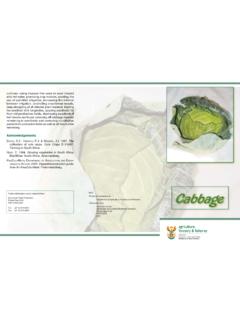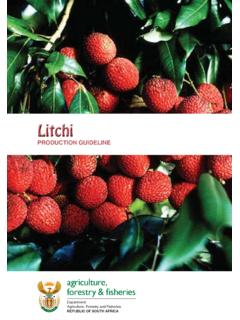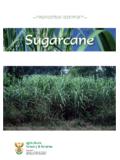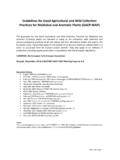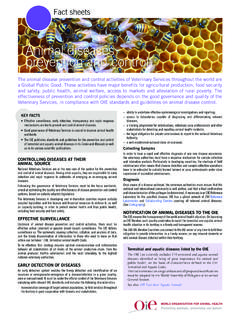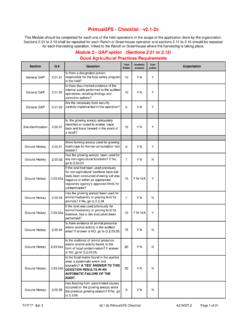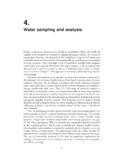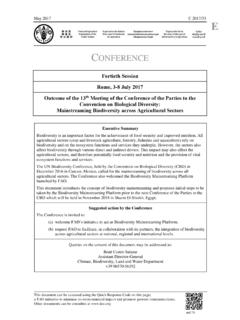Transcription of - PRODUCTION GUIDELINE - for Bottle Gourd
1 - PRODUCTION GUIDELINE -forBottle Gourdagriculture,forestry & fisheriesDepartment: Agriculture, Forestry and FisheriesREPUBLIC OF SOUTH AFRICA- PRODUCTION GUIDELINE - Bottle Gourdfor2016 Printed and published by Department of Agriculture, Forestry and FisheriesDesign and layout by Communication Services Private Bag X144, Pretoria 0001 DISCLAIMER This document has been compiled by the Department of Agriculture, Forestry and Fisheries and every effort has been made to ensure the accuracy and thoroughness of the information contained herein. The department cannot, however, be held responsible for any errors, omissions or inaccuracies in such information and data, whether inadvertent or otherwise. The Department of Agriculture, Forestry and Fisheries, therefore, accepts no liability that can be incurred resulting from the use of this 1: General aspectsClassification 1 Origin and distributionProduction levels in South Africa 1 Internationally 1 PRODUCTION areas in South Africa 2 Cultivars 2 Description on the plant 2 Climate change 4 Soil requirements 5 Part 2: Cultivation practicesPropagation 5 Soil preparation 5 Field layout and design 5 Planting 5 Fertilisation 6 Irrigation 6 Weed control 6 Diseases control 6 Pest control 6 Harvest maturity 6 Harvesting method 7 Part 3: Post-harvest handlingSeed harvesting 7 GradingStorage 7 Marketing 7 PRODUCTION schedule 8 Part 4.
2 Utilisation Acknowledgement 10 References 101 PART I: GENERAL ASPECTSCLASSIFICATIONS cientific name: Lagenaria siceraria Common names: Bottle Gourd , calabash Gourd ; kalbas; moraka ; segwana; iselwa Family name: Cucurbitaceae ORIGIN AND DISTRIBUTIONIt is generally accepted that L. siceraria (previously known as L. vulgaris Ser.) is indigenous to Africa and that it reached temperate and tropical areas in Asia and the Americas about 10 000 years ago, with human help or probably as a wild species whose fruits had floated across the seas. Fruits are known to float in the sea for many months without the seeds losing their viability.
3 Independent domestications from wild populations are believed to have occurred in both the Old and New Worlds. African and American land races (subsp. siceraria) are morphologically distinct from Asian land races (subsp. asiatica). It is uncertain if the seemingly spontaneous populations in Africa are truly wild. However, it is possible that Mary Wilkins-Ellert discovered an unusual free-living plant of L. siceraria in a remote region of southeastern Zimbabwe fairly recently. In southern Africa, L. siceraria has been collected in Namibia, Botswana, Swaziland and the Limpopo, North-West and Gauteng provinces of South Africa. Most, if not all of these collections probably are from cultivated plants or plants that escaped from cultivation.
4 PRODUCTION LEVELS IN SOUTH AFRICANot much information is available on the PRODUCTION of Bottle Gourd , especially in the Southern African context where women are the main custodians of its husbandry. The FAO provides combined PRODUCTION data for pumpkin, squashes and gourds; as such there is difficulty in ascertaining the exact amount of global Bottle Gourd PRODUCTION In South Africa the crop is only available as a landrace with no commercially produced seeds. InternationallyIn Bangladesh, it was reported that yields of 35 t/ha in sub-tropical to tropical conditions and less than 20 t/ha in semi arid conditions obtained. Hybrid 2varieties in Asia have recorded yields of more than 40 t/ha under optimum conditions, while local landrace varieties produced less than 25 areas in South AfricaThe crop is mainly produced in the Limpopo, Gauteng, Eastern Cape, KwaZulu-Natal and North West cultivars have been developed in South Africa as yet.
5 Description of the plantMatured plantBottle Gourd can be a tree or fence creeper, or it can grow on the ground like most other members of the pumpkin family. It is annual and dies at the end of each growing Lagenaria vine stem is deeply grooved and angular (weakly five sided) in cross-section. There are five longitudinal ridges which are deep on the main (1-3cm thick) stems, but smooth out toward the growing tips where the stems are 1cm thick. The stems are softly pubescent with jointed, gland-tipped hairs. The main stem branches out to 5-6 main lateralsLeavesBottle Gourd is an annual herbaceous plant with a prostrate or branching type growth habit.
6 The leaves are alternate and variable, and tendrils are almost always present. Bottle Gourd has large, rounded hairy and kidney shaped leaves with a pair of tendrils at the base of leaf stalk. 3 Roots Like the vine shoot, the root system is wide spreading. The roots are white to pale cream, smooth and circular in cross-section. The taproot can penetrate down from 60 to 80cm, but the bulk of the root system spreads out and inhabits the topsoil (15 to 30cm, depending on soil depth). In a friable soil one would expect the root spread and mass to at least match those of the top growth, as with most cucurbitsFlowersFlowers of L.
7 Siceraria are monoecious in nature, where solitary male and female flowers are found on different plant axis of the same plant, thus cross pollination is highly favourable. Dioecious and andromonoecious sex forms bearing hermaphrodite flowers also exist in wild, non cultivated types. The large white flowers open at night. Female flowers are short-stalked while male flowers have long stalks (10 cm or longer). FruitsThere are many forms, shapes, and varieties of gourds each producing a different-shaped and sized fruit, from small and round to large some with an elongated, narrow neck. The fruit is green at first, but becomes pale brown when it ripens and dries out.
8 The dry fruit are popularly known as calabashes.(1 cm) wide. They have six thin petals. A single female flower is found at the base of a male flower stalk. The flowers are mostly unisexual and white or yellow; they occur on the same plant (monoecious) or on separate plants (dioecious). Male flowers are fascicled, very small, and much shorter than the hispid petiole whereas female flowers on longer Seeds The seeds of Bottle Gourd are flat, more or less rectangular to narrow trapezial, whitish to dark brown at the distal end. They develop inside the fruit and show great diversity in shape and sizeCLIMATE AND SOIL REQUIREMENTST emperatureBottle Gourd like plenty of sunlight and do not grow well in shady areas.
9 The plant grows well under warm temperatures (25 to 35 C). Under frost free, low temperature conditions it will also grow well provided the plants have attained sufficient vegetative growth before the onset of cool weather. Optimum germination temperature is between 20 and 25 C. Temperatures below 15 C and above 35 C reduce the germination rate. RainfallIn South Africa, Bottle Gourd grows well in areas with rainfall of between 400 to 600 mm per annum and that are 245 to 1265 m above sea level; however, 5moderate, rather than excessive soil water is desired for good crop growth. Therefore, Bottle Gourd is intolerant of water logging SOIL REQUIREMENTS This cucurbit has been observed to do well in a range of soils, which are fertile and well aerated.
10 In the wild it grows on a variety of soils, from sand to clay. PART II. CULTIVATION PRACTICESPROPAGATIOND epending on weather conditions, seed can be sown directly or it may be raised in the nursery and then transplanted. In the case of transplanting, seeds can be sown in poly pots filled with mixture of soil and compost manure and transplanted at four to five leaf stages. With some variation, seedlings are transplanted with inter-row spacing of 1,5 to 2 m, and intra-row spacing of 1 to 2 m. During the rainy seasons, Bottle Gourd is usually planted on mounds and during the dry season in depressions. The seed should be soaked in water overnight, so that they absorb water which softens the seed coat.
